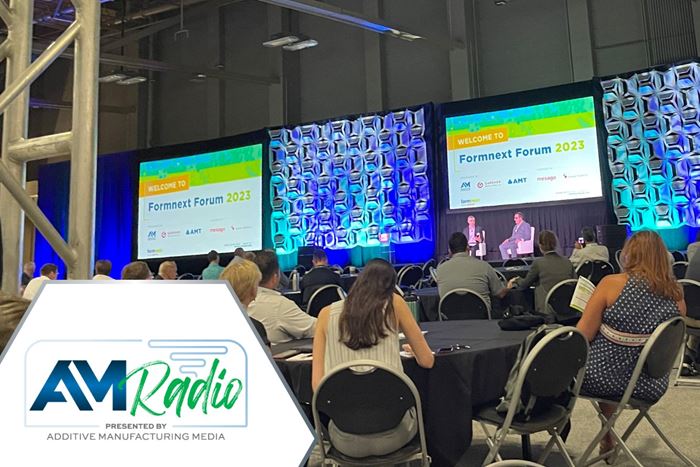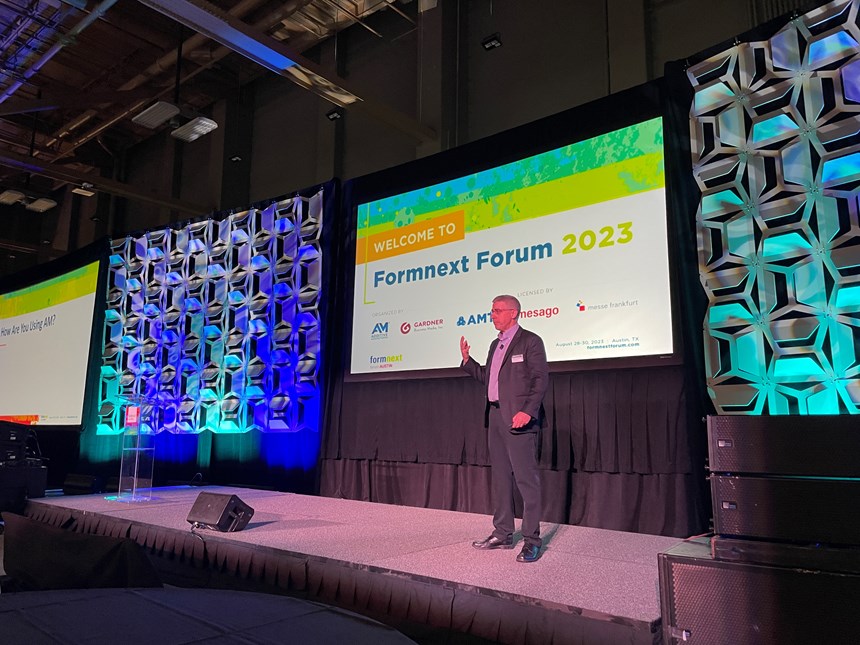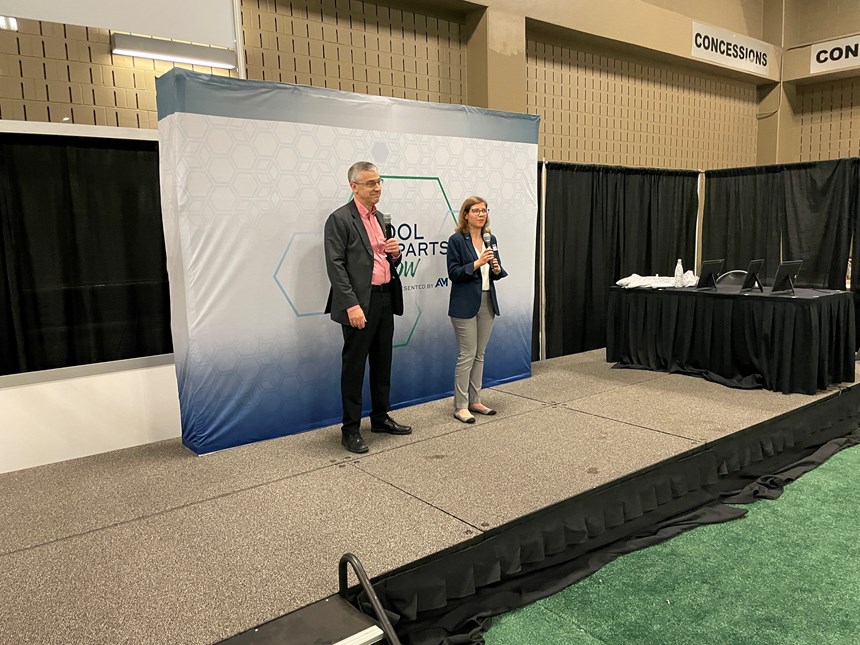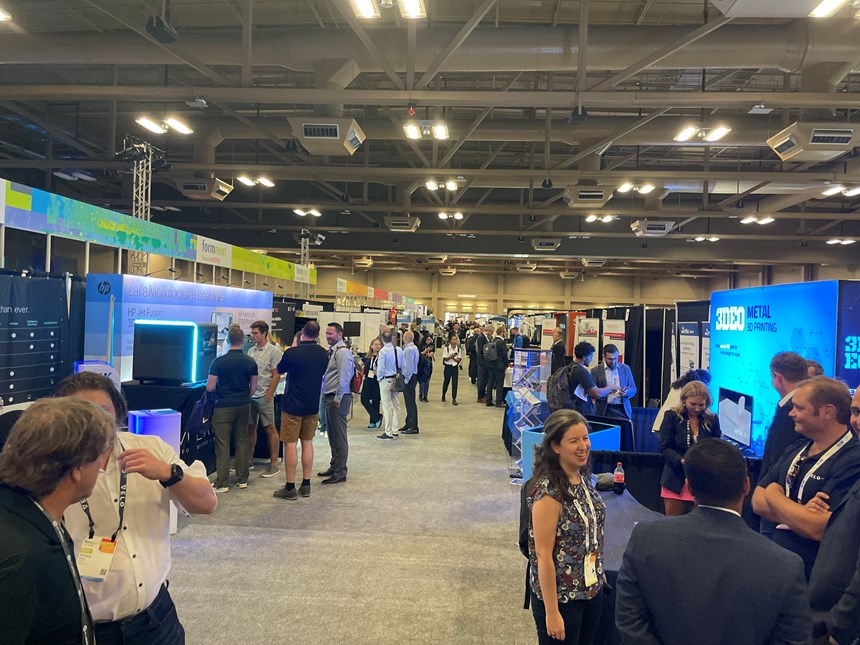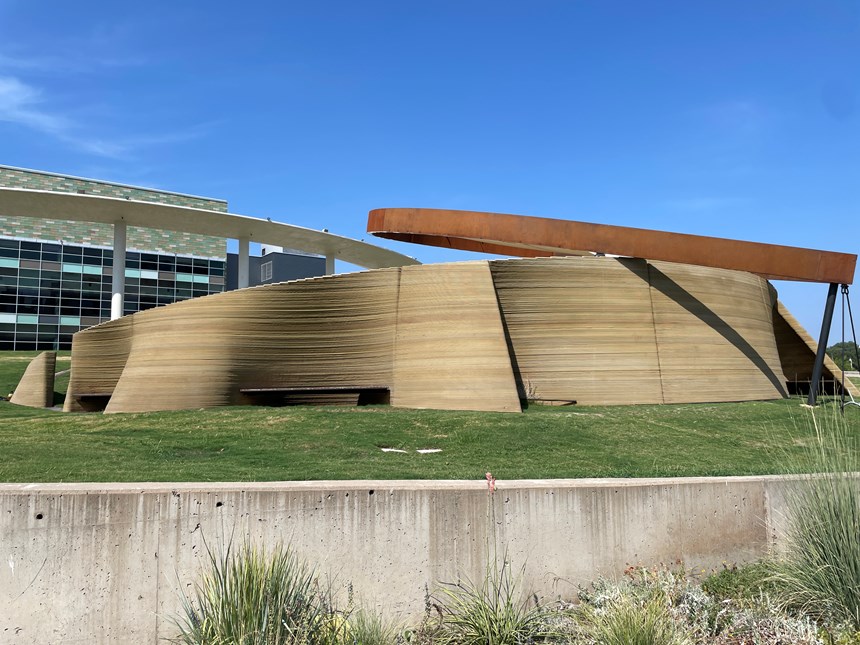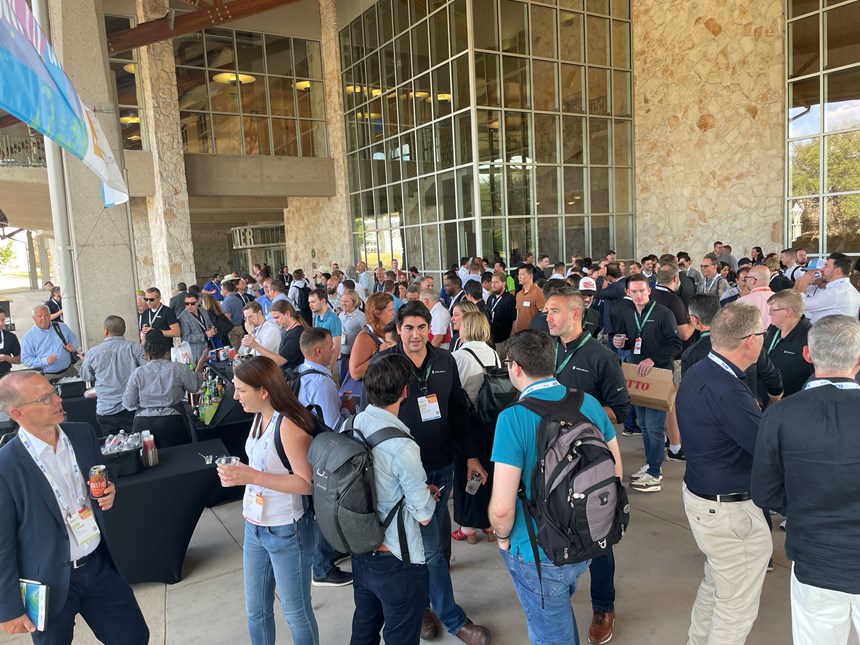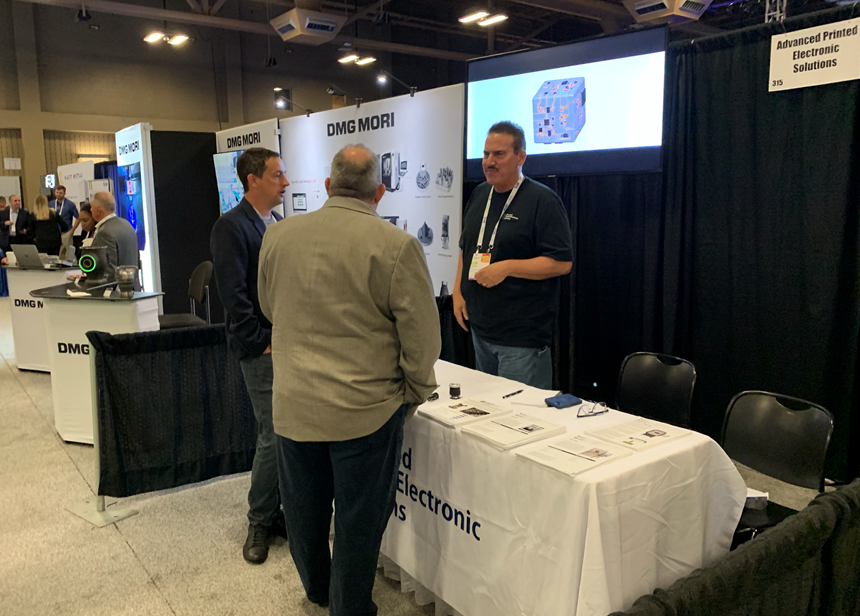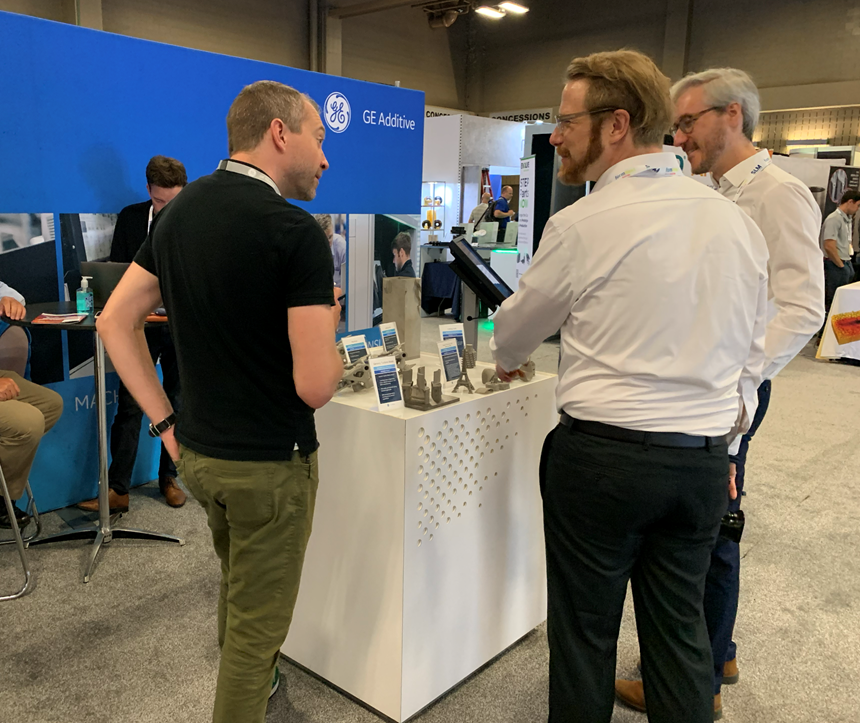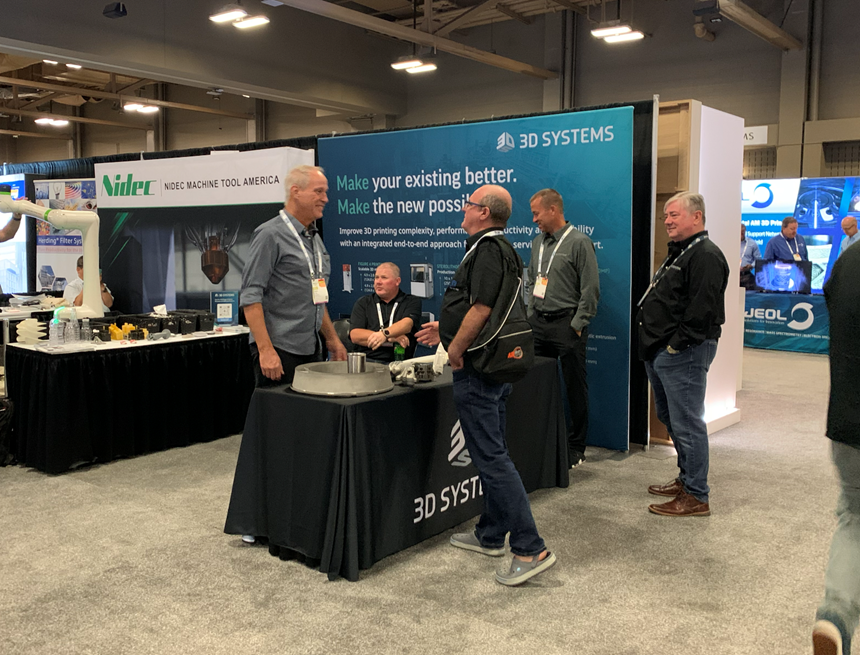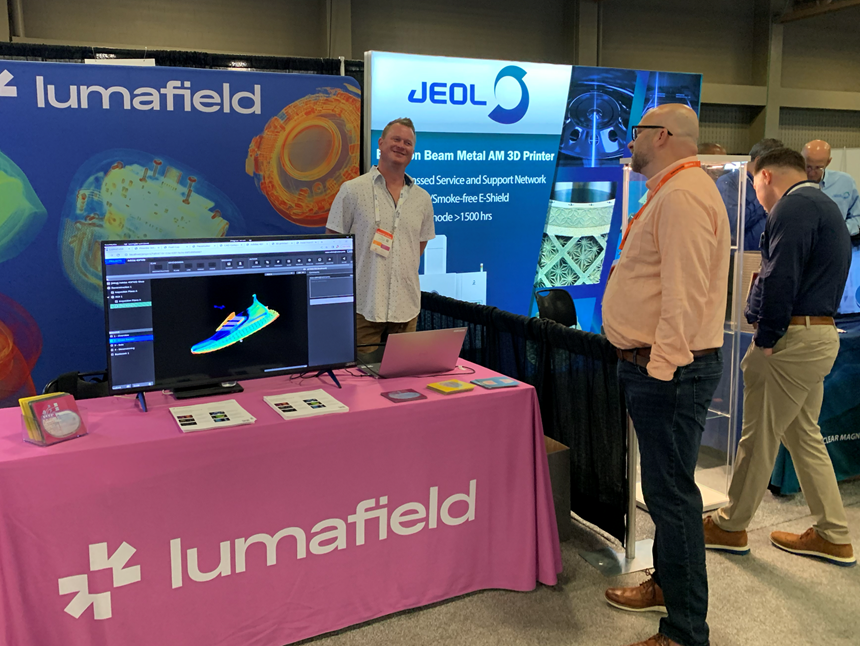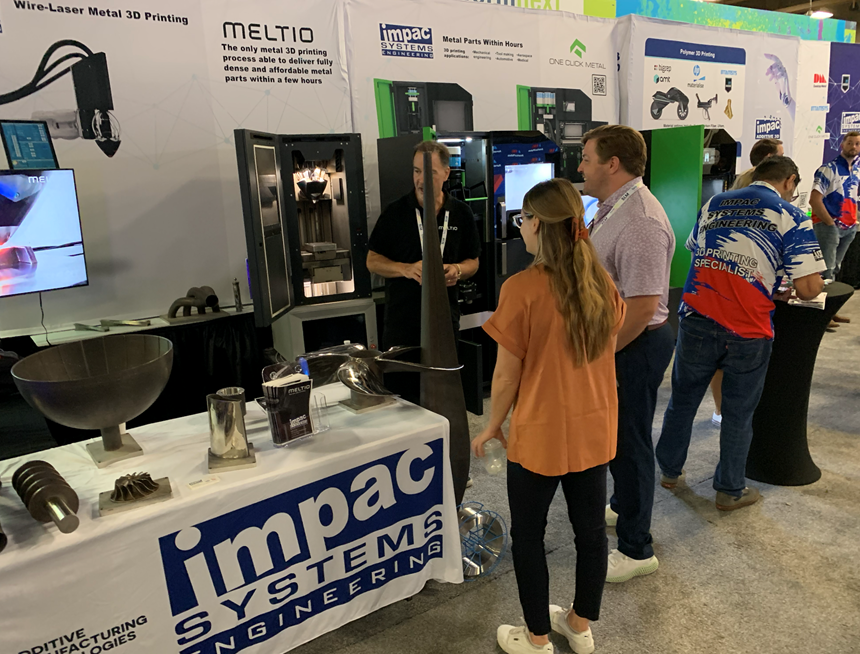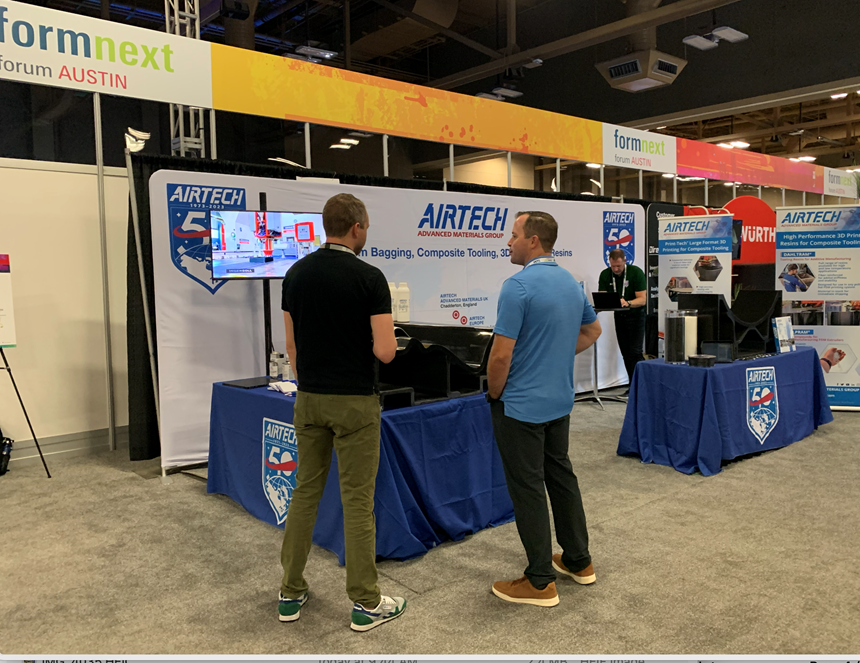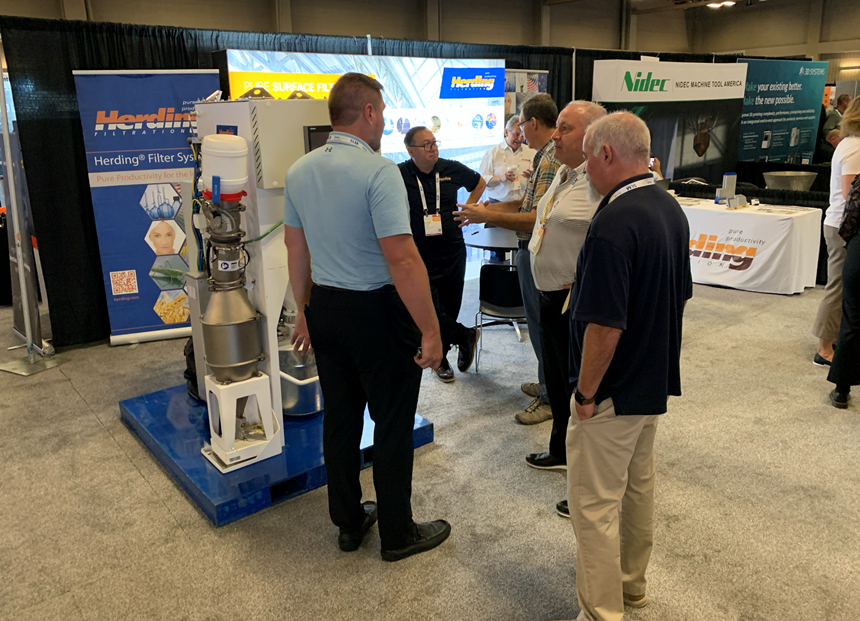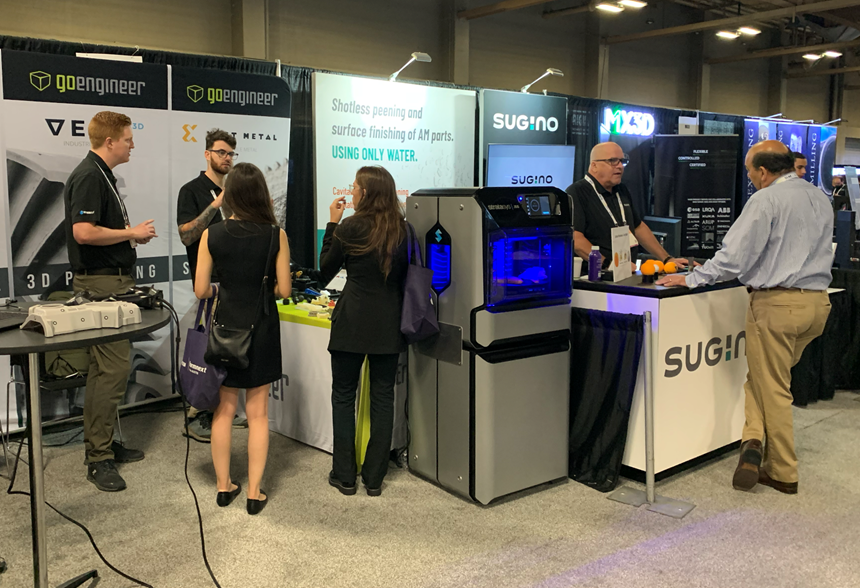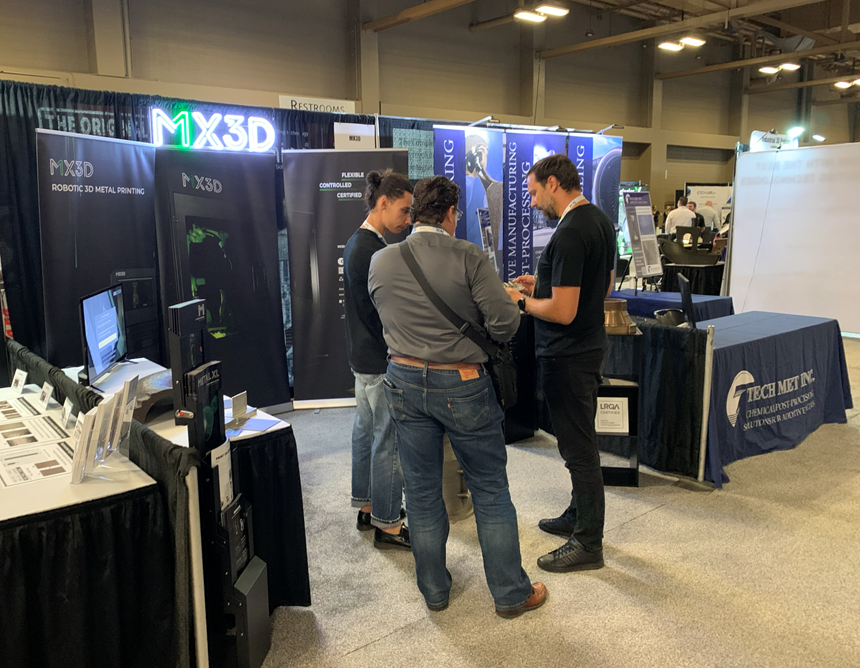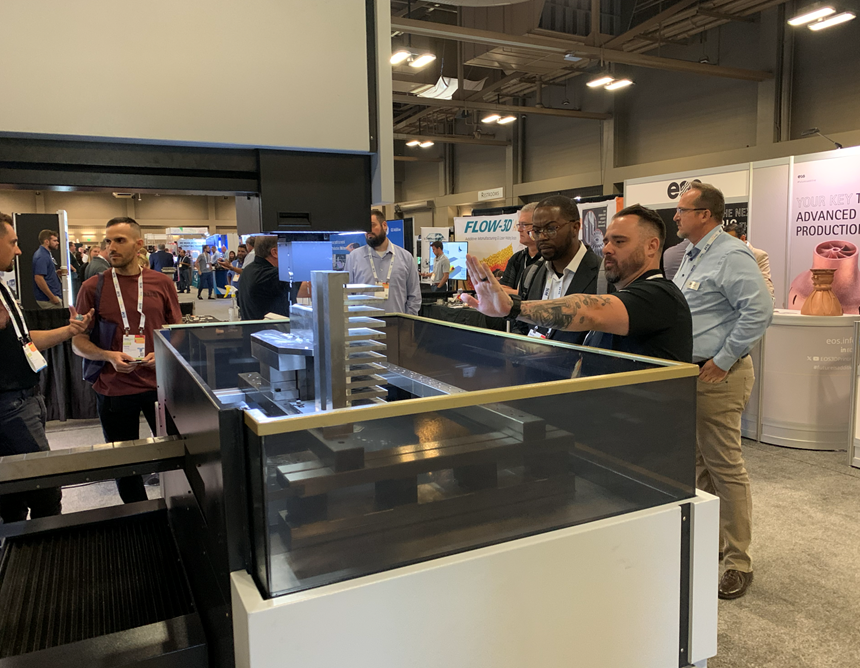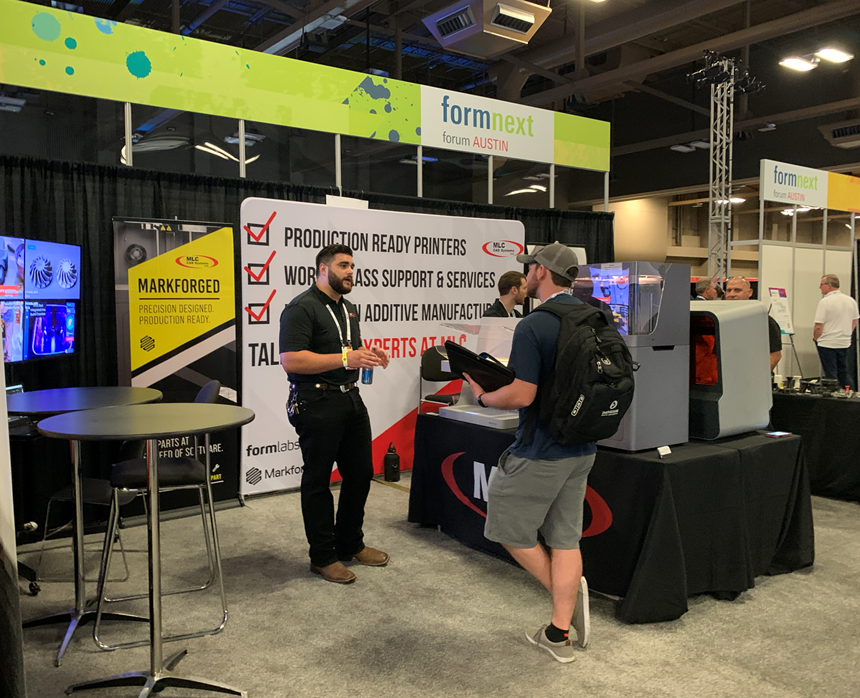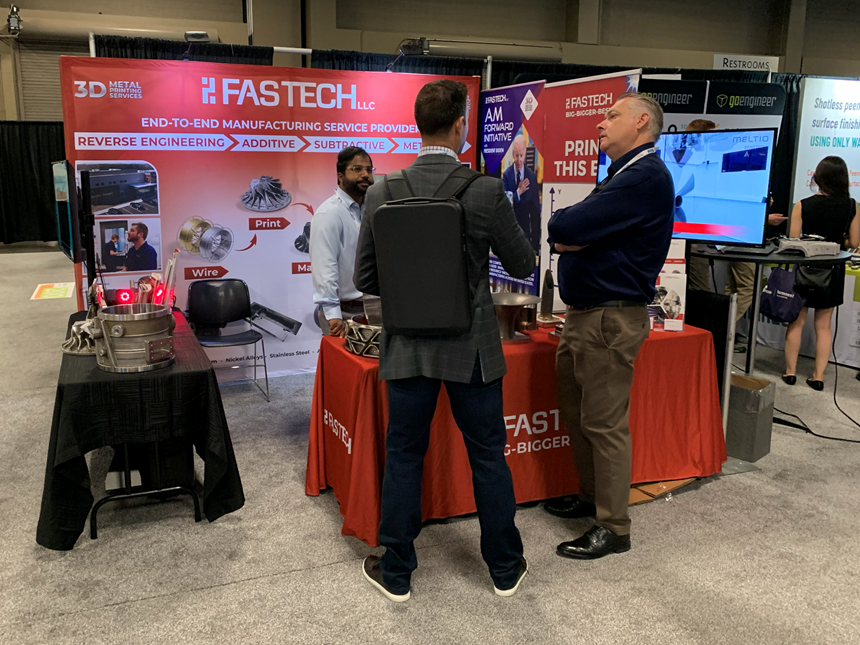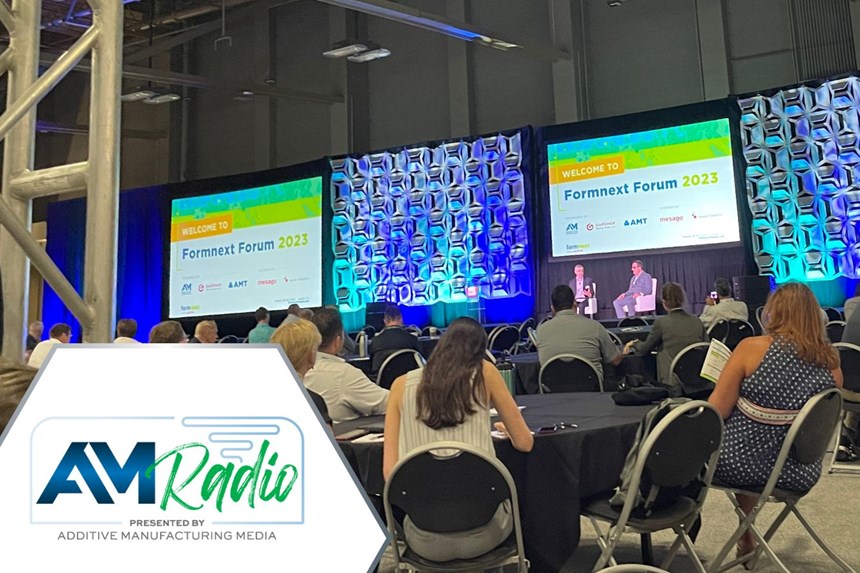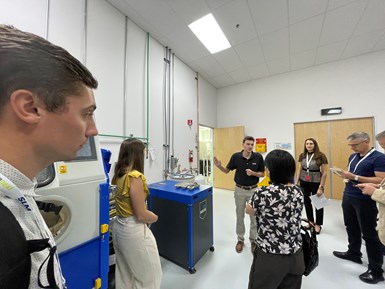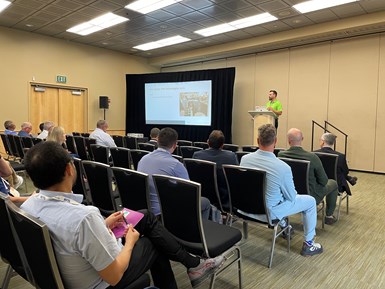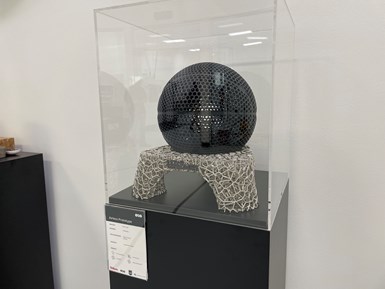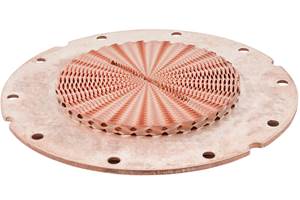Formnext Forum Austin, the first Formnext event to be held in the United States, concluded August 30 after two full days of conference programming dedicated to industrial additive manufacturing. The event is jointly organized by Mesago Messe Frankfurt, AMT — The Association For Manufacturing Technology, and Gardner Business Media, the publisher of Additive Manufacturing Media. Along with sessions on additive end markets, production applications, AM technology and design for additive manufacturing (DFAM), Formnext Forum included a lively expo featuring nearly 80 exhibitors plus The Cool Parts Showcase area displaying contest finalist parts. Attendees also had access to several facility tours and networking opportunities. The event drew more than 900 attendees, including the editors of Additive Manufacturing who were on hand to facilitate and report on the proceedings. Peter Zelinski, Fiona Lawler and I recorded this conversation for AM Radio shortly after the event. Listen to the episode above or read on for the transcript (and photos of what we saw!).
GALLERY: Formnext Forum Austin
Transcript
Stephanie Hendrixson 00:05
Justifications for additive are changing, AM users are maturing in their journeys but some activities like customer education remain. All these and other insights from the first Formext Forum in North America on this episode of AM Radio.
Peter Zelinski 00:28
The AM Radio podcast is brought to you by The Cool Parts Show, a video series dedicated to highlighting unique, unusual and innovative 3D printed parts. Watch episodes at thecoolpartsshow.com.
Additive Manufacturing Media editors Stephanie Hendrixson and Fiona Lawler at Formnext Forum Austin 2023.
Photo Credit: Additive Manufacturing Media
Stephanie Hendrixson 00:45
Welcome to AM Radio, the show where we tune in to what's happening in additive manufacturing. Today on the show we're going to be talking about Formnext Forum Austin. This is the first of several Formnext events that are coming to the United States. The event happened in Austin, Texas, at the end of August and we're going to be discussing the things that we learned there, the conversations that we had and our takeaways about where additive manufacturing is headed. So I'm Stephanie Hendrixson with Additive Manufacturing Media. I am joined today by my two co-hosts, Fiona Lawler. Hi Fiona.
Fiona Lawler 01:15
Hi, Stephanie. Thank you.
Stephanie Hendrixson 01:16
And Pete Zelinski. Hi Pete.
Peter Zelinski 01:17
Hi Steph. Hi Fiona.
Stephanie Hendrixson 01:19
So let's dive into it. What is Formnext Forum? What just happened? What are we going to be talking about today?
Peter Zelinski 01:24
What just happened? Okay, first Formnext event in North America. And we should say right out of the gate. It was our event, we were hosting it. So we are a little bit biased in talking about this, just acknowledging that upfront. It was a very successful event. This event is a partnership. Our employer is Gardner Business Media partnered with AMT, creators of IMTS and partnered with Mesago Messe Frankfurt, creators of the Formnext show in Germany. And this is the first of what will be a series of Formnext events in the US. For comparison. We were in Austin once before with an event, actually multiple times before, but most recently was in 2019. We did our AM Conference there. And this event proved to be at least twice the size of what that conference was. And we weren't necessarily expecting that. We aim to do a smaller event, a conference and expo and it got pretty big for a small event. Attendance is hard to know at this stage, inside baseball, you have to analyze attendance figures to see if there are duplicate names you picked up and all that and we haven't gone all the way through that yet. But we know for sure we had more than 900 attendees there. 82 exhibitors in the expo area, a complete conference program across two days. And it was a very energetic event. It was like big, but also the right size, lots of interactions and conversations among very serious people focused on additive manufacturing for production.
Stephanie Hendrixson 03:09
So Pete, you mentioned our conference in 2019, that was also held in Austin. And the feel of that event was much more of a conference like people were in just one track watching the same programming all together. Here in 2023, at Formnext Forum, we had four different tracks. We had a lot of conference programming offered. And the thing that was really striking to me was how much time people also spent on the expo floor. Every time I walked through, it seemed really busy. It seemed like people were having those those good interactions. But at the same time Formnext Forum was not a tradeshow it was meant to be more of a conference focus, the event that's coming in 2025 Formnext Chicago is going to be a trade show. And it's going to have more of that feel like you would get from the Formnext event in Frankfurt, Germany.
Peter Zelinski 03:50
Right. So that phenomenon you're describing how busy the expo area was all through Formnext Forum. Like from the beginning, this kind of compact expo area was part of how we conceived the show all along. But, how much energy and activity there was there is not something we necessarily did anticipate. It was like really a really happy development of this show. And as you say, it tees up the Formnext event that's coming next in April of 2025. Formnext Chicago is this full blown trade show. And it's something that makes these US Formnext events a little bit confusing, because there's two of them, we will continue to do Formnext Forum, which is this more concentrated conference program. And then there will also be the trade show Formnext Chicago, but Formnext Forum is what we want to talk about.
Stephanie Hendrixson 04:40
Yeah, so let's get into it. The three of us were in different places at times. We saw lots of different things at this event. And let's just take this episode to look at a couple of big themes that we noticed and talk about what we observed, what we learned.
Peter Zelinski 04:53
Sounds good. Let's do it.
Stephanie Hendrixson 04:54
We're gonna start with something I noticed that I think is just indicative of the the Formext brand and the Formnext event. So people who have been to the Formnext show in Germany, it's the I think the world's largest additive manufacturing trade show, and covers like three to four of these really large exhibit halls in Frankfurt. And the distinctive thing to me about that show is how the technology represented really covers the entire workflow of additive manufacturing. So it's not just 3D printing, you see a lot more than 3D printers there, including things like sometimes machine tools, and depowdering stations, and really sophisticated automation for sorting parts and stuff like that. And I feel like that sort of focus on AM as an ecosystem, as this full workflow that includes a lot around the 3D printing, as well as the 3D printing was a focus both on the exhibit floor, but also in a lot of the sessions that I attended. Like I heard people talk about AM as an ecosystem a lot.
Peter Zelinski 05:52
It's a nuanced point. But it's a really important point. And it speaks to the reason why we're going forward with this, this new different event brand in the US. It's all about additive manufacturing. This, this isn't one more showcase for 3D printing, or even industrial 3D printing. Additive manufacturing is more than 3D printing. The two terms aren't synonymous, additive manufacturing is the production operation that has 3D printing at its heart. But, even though these other aspects of the process do find places at other venues that are showcases for 3D printing, this really was an event that talked about the entire integrated additive manufacturing workflow, that really was the spirit of this event. And so that brings in more than just 3D printing and designing for 3D printing, there are materials, there is machining, there is finishing, there are various software considerations. And all of that had equal footing and an integrated place across the way that people who were key voices in this event were presenting and talking about their successes with additive.
Stephanie Hendrixson 07:09
The tour of EOS’s Pflugerville facility included a stop in the postprocessing room, underscoring the importance of finishing steps for polymer SLS parts and the fact that the additive manufacturing ecosystem includes much more than 3D printing. Photo Credit: Additive Manufacturing Media
And you know what that even started the day kind of before the conference began, before the conference programming. On Monday, we offered tours of some local additive manufacturing businesses. So, attendees who signed up for that got to go visit EOS and Cumberland Additive in Pflugerville. And so the Cumberland tour kind of stands out to me because they started us all, they did like a staggered start with each small tour group, starting us off in the conference room and kind of talking about how their engineers work with their customers. And you know what that early discussion looks like. And then we sort of step through all the stages in the additive manufacturing process, went into the printer rooms, talked about the different technologies that they use, and kind of ended up in the machine shop. So we kind of you know, went all the way from the design and the those early meetings with the customer through what the manufacturing looks like, what the inspection looks like. And then what machining and postprocessing might look like.
Peter Zelinski 08:00
The EOS part of that tour even illustrated that same thing and EOS, they make machines for 3D printing. Metal and polymer. And they showcased various technologies throughout the tour, but one of the things they showcased was that 3D printed basketball and the story of that, which that is in its way, this integrated workflow story. It's this success reliant on 3D printing, but also not possible, if not for the engineering work General Lattice did, if not for the finishing work, that Dye Mansion did all of that had to come together to realize that success.
Stephanie Hendrixson 08:38
This is a really good point. And we actually have a bonus episode of The Cool Parts Show about that basketball, which you can find on our YouTube channel. We'll link to it in the description.
Fiona Lawler 08:46
So like you guys just mentioned with the two tours kind of taking us through the very beginning of the additive process all the way to the end. I kind of saw a similar example of this, but it has to do with sustainability. And I think it's important to note that sustainability does demand looking at optimizing all steps throughout the workflow. So on the expo floor, I was actually able to speak with Greg Kline, sales manager of 6K Additive, a company that processes waste material and byproducts for additive manufacturing. So this could be any number of things whether it's leftover powder or shavings from traditional manufacturing. 6K then is able to process it down and puts it through reactors to create this feedstock. This sustainable production process of metal powders creates no waste, it produces lower greenhouse gases and even less energy consumption. What's interesting here to me is that it's not just the finished product that's sustainable, but the entire process to make it. Say a company brings leftover waste or leftover powder to 6K Additive, they can then transform this into powder they can use for their next build cycle and then the leftover waste from that can just be continuously reused. So this is not only a sustainable service, but it's a sustainable process throughout the workflow.
Peter Zelinski 09:59
That process control for sustainability was a huge factor that kept coming out. I got to have a conversation on stage with James DeMuth, the founder of Seurat, and he got challenged by an audience member about his company's business model. Why is he offering his technology as a part-making production service rather than selling machines? He gave a lot of good answers to that. There are many reasons, but one of them is sustainability requirements that additive manufacturers in particular seeing like he pointed out in the part-making contracts they're getting, they're getting, it's in the contract this much greenhouse gas emissions, this much carbon, like requirements like that are spelled out. And being able to have visibility into, if not control, the entire process flow is the way to meet those requirements.
Stephanie Hendrixson 10:56
So I think actually, that leads us into kind of the next big theme or bucket of stuff that we wanted to talk about. And that's that additive manufacturing justifications are shifting. So James DeMuth brought up this point that, you know, customers are asking for reduced carbon, and things like that in their contracts. And I noticed throughout a lot of the programming, the reasons to use additive manufacturing are different than we might have heard a couple of years ago, where the focus was more on like design and the geometric possibilities. Here, people were talking a lot more about the cost savings, the lead time advantages. It's a lot of different reasons to choose additive came out, I think.
Peter Zelinski 10:56
What you're saying Stephanie, is what I feel like I saw as maybe the biggest, most fundamental theme running through this event, the most striking thing for me, in his presentation, Greg Hayes of EOS identified this explicitly. He showed survey responses, 2019 versus 2023, asking people basically, what do you think the role of additive manufacturing is? Why is it important? Supply chain and inventory registered as high importance to a very low number of survey respondents in 2019. But that same category was important to over 50% of the survey respondents in 2023. So the idea that additive is this enabler to really elaborate geometries that you can't get any other way. That's true, it hasn't changed. It's a promise of additive. But it's not the promise people seem to be focused on now. The promise now is a responsive supply chain and flexibility in the supply chain. It is logistics, it's inventory. It is the overall total cost of production. When you factor in how much you have to make and how much you have to store when you're not using additive. All that stuff is what people are focused on right now.
Stephanie Hendrixson 12:58
Yeah, so one example of that, there was a section on the expo floor for The Cool Parts Showcase, which was this contest that we ran this year, to find new subject matter for for The Cool Parts Show. We have 15 parts in three different categories. One of the parts that ended up winning the production category is this valve trim from Baker Hughes. So earlier in the conference, actually, before we even knew that they had won, I went over to the Showcase area and Rohan Buntval, who submitted that part was standing at the table and we chatted for a few minutes. And what I learned was, this is a component that conventionally it would be made of lots of stacked sheets of metal, like they drill holes through them, and then they stack them all up, and they brace them together. And when you look at the 3D printed versions that were on display, now made through laser powder bed fusion, the design really isn't that different. Like they didn't change a lot about the way this component looks. They made a couple of tweaks that he pointed out just to make it easier to 3D print, easier to postprocess, but it basically looks the same as one of these conventional components in kind of a broad way. And so I sort of keyed in on the fact that this is like serious assembly consolidation, they're saving all of these separate components, but they're also consolidating manufacturing, they don't have all of these extra joining processes and things that they would otherwise. But what Rohan pointed out was that actually the reason that they chose to make these components this way, is not any of those things. It's really the the lead time, they wanted to be able to make them a lot faster. And so 3D printing is getting them there. And so that to me was a good illustration of this at work.
Peter Zelinski 14:29
The Cool Parts Showcase was, was really exciting, really fun. Audience members and attendees at the event voted on their favorites, and we announced the winners live, but just to highlight what you were saying Stephanie, Rohan's part won. And during the live announcement, he brought that part to us and I watched him and you can see it in the live stream which will link to the recorded version of it. But as he's walking toward the stage to hand us this part, I just had the thought this thing he's carrying, you could never tell that's an additive part. It looks like a metal donut, it is a donut with a lot going on inside. But additive is now winning and the process of choice for parts and geometries that could very credibly be made in exactly the same form through an altogether different process. And that's a big change.
Fiona Lawler 15:20
So like you just said, Pete, even though the justifications for AM are maybe shifting away from design, I think it's important to note that we did have an entire design for additive manufacturing track, I spent a lot of time floating around this track. And one speaker session I think is important to note here, I listened to Daniel Baker, program manager with the manufacturing and engineering company Endeavor 3D. And he talked about the importance of understanding which parts are actually suitable to create via AM, and how design for additive manufacturing can be used to confirm this. And he said, deciding which parts are worthwhile to make additively just in terms of cost savings and production time, but as well as functionality is extremely crucial. And then once the best AM route is established, determining how to qualify these parts to ensure reproducibility is equally critical to optimize the production and eliminate certain supply chain issues that we're seeing. So the end-to-end service provided by Endeavor 3D means that customer can get exactly what they need throughout the production and post-production process. This means taking away the middleman and speeding up the entirety of the process. I can see a tie in here with Cumberland Additive as well, you know, they talked about customers sometimes coming in and saying, hey, I want to 3D print this part. And then the engineers, you know, working with them come back and say actually, you know, it might be cheaper and quicker to produce this via traditional manufacturing instead.
Stephanie Hendrixson 16:44
So yeah, that's right design was still an important part of the conversation and the tours and everything at this event. And thank you to Tim Simpson from Penn State who hosted and kind of organized that whole DFAM track. So we did have one track of a conference that was devoted to these issues of design for additive manufacturing. But Fiona, I think what you just said is really important that it's not an isolated decision. Like you can't just take this component that you would have got cast or injection molded or something and just make it additively without having those conversations also about the design and and whether or not it actually makes sense for additive.
Peter Zelinski 17:21
Trevor Johnstone of Designfusion speaking at Formnext Forum Austin 2023.
Photo Credit: Additive Manufacturing Media
These topics are related design for additive manufacturing is an enabler to the supply chain resiliency that was so apparent as a priority throughout this conference, I think of our production track that was running in parallel with that DFAM track. One of the speakers was Trevor Johnstone from Designfusion, who gave this fascinating talk, I think about the different unseen possibilities for production through additive manufacturing. He focused in part on accessories for unsupported legacy products and additive's chance to do production for that. He talked about a company succeeding with film camera accessories that are 3D printed and the way design figures in, the way he revealed that design figures in, design the part for nesting within a Multi Jet Fusion machine, do more production, through design, not necessarily designed for the functionality, a component designed for how it all fits together in the production batch. And it can dramatically change the economics of additive production.
Fiona Lawler 18:36
So I totally agree with you Pete, and I think DFAM, or at least optimizing DFAM is really important in the production cycle. Carolyn Seepersad, professor of mechanical engineering at Georgia Tech actually talked about this in one of the DFAM sessions. And she talked about improving time to market using DFAM, and how the goal here is addressing manufacturing supply chain issues. One way to do so that she talked about is her work with processor designs, and how machine learning algorithms can aid in this workflow. So one project specifically that she's working on is called Recreate It, which is essentially working to transform plastic waste to build home furnishings based on customer design and demand. So the algorithms being used in this project have the capability to create thousands of designs, enabling customers to design and change their designs, you know, based on height, weight, width, material, etc. And it not only speeds up the process and implementing already available designs, but does enable for this customization factor.
Peter Zelinski 19:38
It's actually all happening. And maybe the way that I'm framing it, is it design that's the promise of additive, is it logistics that's the promise of additive? It's all happening and one speaker who tied it all together, Kyle Spieles of Eaton Aerospace spoke. We've covered Eaton Aerospace on additivemanufacturing.media we'll link to the the article. They have an additive production facility recently opened in South Carolina. And he talked about these different levels of win that Eaton is seeing through additive. So he spoke of the part level. And that's where supply chain robustness is really important. Additive for particular parts that might be needed quickly. Then there is additive at the assembly level. And that's where assembly consolidation is used through additive to save weight, or improve component performance or reduce the work that goes into assembly. And then there's this third level also that they're really beginning to explore. And that is the system level. And he talked about how there is this fuel distribution system on aircraft that formerly consisted of all these different components spread around different parts of the plane, and it's all been integrated now into this one cartridge in one place made additively. And one result of that, one important side effect of additive scoring this win is the wings on the plane get thinner because of the different hardware that no longer has to be attached to it. So there's all these different places where additive is succeeding, all these different ways, all at the same time.
Stephanie Hendrixson 21:26
So that's one of the exciting things about additive, right? Like you can do all these different things all at once. But it's not straightforward. It's not simple to get there. And I think we should talk about some of the journeys that additive manufacturers have gone on after the break.
Peter Zelinski 21:43
I'm Pete Zelinski.
Stephanie Hendrixson 21:44
And I'm Stephanie Hendrixson.
Peter Zelinski 21:45
You've heard us on AM Radio. But we want to tell you about another great place to learn about additive manufacturing, our video series, The Cool Parts Show.
Stephanie Hendrixson 21:53
In each episode, we highlight a cool 3D printed part that has something to say about where additive manufacturing is headed.
Peter Zelinski 21:59
Join us as we explore the world of custom medical devices, try on the next generation of sustainable footwear, and even follow 3D printed parts to Mars.
Stephanie Hendrixson 22:08
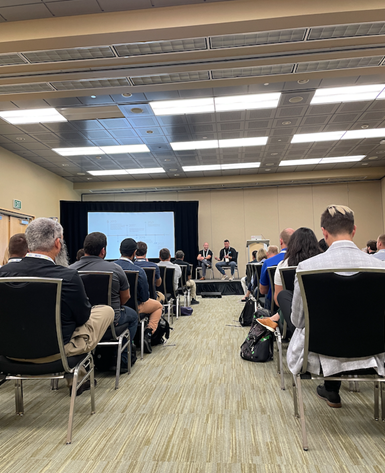
In the Production track, Chris Collins and Adam Clark shared their journey from founding Tangible Solutions in a garage to building a profitable AM business and ultimately becoming Marle Tangible.
Photo Credit: Additive Manufacturing Media
Find all the episodes and subscribe on YouTube or at thecoolpartsshow.com. And we're back. So in the second half of the show today, we have a couple more themes from Formnext Forum Austin that we want to go through. And the first one is this theme that kept coming up of the journey story. So we heard from lots of additive manufacturers who have reached this kind of point of maturity in their application of this technology. And now they can sort of sit back not not really on their laurels, but kind of sit back and look at where they've come from and share some really valuable insights. So in the production track, like we talked about earlier, I feel like this actually came up a lot. We had a lot of companies that at one point could have been described as startups and most of them have sort of shed that label by this point. But a lot of the presentations in that track talked about what it took for them to get started, get off the ground with additive and how they've been able to grow that into a sustainable business now. And so the one that comes right to mind is Marle Tangible. They were the first speakers in that track. This was Adam Clark and Chris Collins, who we've known for many years now. And they shared this journey from how they started this company Tangible Solutions in a garage, and eventually moved it into like a real production facility and eventually got acquired by Marle, which is a French biomedical company. And so they just kind of told that whole story. And so Chris described how they started out with this, like shotgun blast approach. They were trying to be all things to all people, they were going to offer all these different services, all these different types of additive manufacturing. And actually, things didn't really take off for them until they chose this niche. They decided actually, we're going to get really good at 3D printing orthopedic implants, we're going to use one technology, laser powder bed fusion, and we're going to use one platform. They bought machines from Concept Laser at the time, which is now part of GE, and they just really leaned hard into that. It was not an easy journey. They talked a lot about the difficult times that they went through, the fact that like their families sat them down at one point and said, like, Listen, are you really going to do this, this is just so difficult and so hard, but they kept going anyway. And now they're at a point where they can look back and see how all these decisions that they made happened to be the right ones and how they landed in a much better place at the end of all of that strife and difficulty.
Peter Zelinski 24:27
I'm glad we're talking about this and the way you're framing it is exactly right. The Journey story absolutely was a recurring element that we kept encountering at Formnext Forum. And I think what it's indicative of is we're far enough along now with additive that there are companies who have arrived and can look back from that point of arrival and pick out what the lessons are, the paradigm shift you were talking about Stephanie with Marle Tangible, figuring out what their business actually is and how transformative that was. Trying to succeed with a new technology, making products in a new way. For customers who haven't necessarily thought through all of the implications, like this is a hard road to go down. But, now there are companies that have gone all the way down that road and have arrived. The Marle Tangible guys are a particularly striking example. And they, they are very open about some of the like, the pains that still linger with them that they went through, financial struggles, including Adam Clark was talking about how, you know, there were moments where they were crying over an expense of $100. And yeah, and Chris Collins quickly corrected him, Well, you were crying, I'm too badass for that. They have this funny interaction that masks like, like a real genuineness about what they've gone through and how far they've come. And, and they are just one example of yeah, this element of the event that we kept seeing, and it's, it's beyond technology, it's just, it's a very business thing and a very human thing. I guess in that same track, what I think of is Elementum 3D, another company that's been around a while that has been delivering various successes to the market for awhile. Jacob Nuechterlein, the founder, he described how the first success they brought out like utterly, basically wasn't wanted by the market, they innovated this very sophisticated metal matrix composite, this metal ceramic material achievable through 3D printing, achievable through laser powder bed fusion, they didn't get traction with it, in spite of the importance of what Elementum 3D accomplished. Where they did begin to succeed, what the market really wanted, Jacob discovered, is printable 6061 aluminum. And they developed that and brought that out there. And success has started to build on that.
Stephanie Hendrixson 27:00
Yeah, that story stands out. Because Jacob said multiple times throughout his talk, you know, we came up with this amazing material, and nobody wanted it. And it wasn't really until they started having those conversations with, with the market with the additive manufacturers who could use other types of materials that they really landed on that 6061 option and started building towards that.
Fiona Lawler 27:22
So I really liked this point that you make Pete about companies coming out with this printer, or this material or this product, and then the market doesn't really know how to use it, or where to go with this, and it doesn't gain traction immediately. So the journey story I'm going to talk about is a little bit different, in the sense that they kind of thought this through beforehand. So I spoke with technical sales engineer, Brandon Funke of 3DXTech, they were on the expo floor. And he told me how the company started out in materials. So they had this really robust portfolio of about 43 materials. And they were printing with Stratasys technology, but they wanted to expand their offerings, and they really liked the Stratasys printers themselves, but they wanted a more open source model that would allow for more materials to be printed rather than just a select few. So, that's when they decided to create their own printer on the HD2, which was capable of printing all materials, not just one company's trademark material. What's interesting here is that unlike some companies, you know, beginning with the printer, they began with this high end materials portfolio. And then they were able to build their flagship printer to accommodate these as well as any other material that a customer might be wanting to print with. Even if it's not 3DXTech material. You know, this is a company run by polymer engineers attacking application product development. And normally you have a company creating a new printer, a new technology. And then sometimes there's the question, okay, but what materials can I print on it? What's the best use for this technology? And in them starting with having so many material options to then creating a really inclusive printer, they were able to kind of avoid those questions and set their customers up for success.
Stephanie Hendrixson 29:05
So before they got into developing this printer, were they originally a materials developer? Was that the focus? Or were they making parts or was a little bit of both?
Fiona Lawler 29:15
So they were a materials developer, but like you said, it is a little bit of both because they were able to print parts for their customers. And that's when they were using the Stratasys technology.
Stephanie Hendrixson 29:23
And so now they've developed this printer that they're also supplying and are they still making parts for customers?
Peter Zelinski 29:29
I think one final point. There's an asterisk on a lot of these journey stories, because so much of additive manufacturing involves proprietary work. We watched Mark Norfolk kind of struggle with that in the presentation he gave. Fabrisonic, they do ultrasonic additive manufacturing, bonding layers of material together through basically ultrasonic welding. There is a component he was able to allude to only in general terms, but it's a huge success for this process. And, and, and a huge arrival for the journey that Fabrisonic has been on. But it is a, a shunt for an electric vehicle, it's made through this additive process on a machine developed and installed by Fabrisonic. Mark Norfolk said can't name the customer, it's an automaker, we would all know, the numbers he gave, I believe were the 23 million of these parts had been made in 2022. And something like 30 million will be made this year. So a big success for additive that we at least got to get a glimpse of.
Fiona Lawler 29:29
So yes, they can still make parts you know, now using their robust portfolio of materials with this HD2 printer that they created something really cool actually, that they had to show on the expo floor. They are using a material that's really similar to bone and they're using this for more of an ethical alternative to using cadaver bones for graduate students. This material is super dense and it can be printed with minimal support structures and it's just a great option, I think because you, you know, Brandon mentioned sometimes students are a little hesitant to use cadavers, you know, if they're, there's this pressure, like if you mess up. And so 3D printing, this bone-like material is a great option to have instead.
Stephanie Hendrixson 31:16
And I think those glimpses are really important. You know, even if you can't say what vehicle it's going on to or who the customer is, being able to actually see a photo of that part and kind of understand what it's all about and why it's such a good fit for ultrasonic additive manufacturing, was really useful, because you never know who could be in the audience, it could be somebody else who has a part that looks like that, that is now going to investigate Fabrisonic because they saw that talk and they and they learned a little bit about this mysterious part made for somebody else. That's part of the value of the showcase, that's part of the value of The Cool Parts Show, I had a couple of conversations on the floor with people who said, you know, I recommend that my clients or my potential clients go watch episodes of the show, because there are great examples of how additive can succeed. And it's like, we don't need to have an episode that exactly describes the type of part that somebody is thinking about making. But, if it's something close, and they can see how that technology or that material or any of the factors involved could translate to their application, like that's a potential win. And so providing those illustrations, I think, is a really valuable thing that happened at Formnext Forum, and that happens in a lot of our media, but in particular at this event.
Peter Zelinski 32:25
Preach.
Stephanie Hendrixson 32:26
I think maybe the next big bucket that we want to talk about is customer education. And I want to just kind of underscore the fact that seeing good examples of additive successes is really valuable for customers and for potential customers especially. So not to keep coming back to The Cool Parts Showcase, but there were lots of really cool parts in that in that area. And one of the other parts that we had on display was this helmet that was sent to us by Jabil, is a bicycle helmet. And the customer's name is KAV. Basically what they do is they produce these custom helmets based on the geometry and the measurements of each individual wearer. The helmets are made from this filament, this material that Jabil developed specifically for the application. And it's a little bit distinctive, because these are bike helmets that are made through fused filament fabrication through extrusion. And I talked to Jesse Sumstad of Jabil, who's the one who submitted this part to us about that. And he kind of underlined the fact that it was really exciting to see not just a part in the Showcase that was made through FFF, but a consumer part that was made through this process. He said, You know, it gets kind of an unfair reputation as being associated with tooling or with prototyping. And it was important and exciting for them to be able to show this customer product that is made from filament, made on just desktop printers, but it is a high-end quality product that is suitable for use and something that you can buy right now.
Peter Zelinski 33:50
Yeah. And what's wrapped up in that is the conversation that Jabil would have had to have with KAV all along in the development of this product. And so you've got us to a different topic. Now we were talking about company journeys before. There's this customer journey too, and the ongoing need to continue to educate customers to unlock the promise of what additive can do. In the Marle Tangible presentation. I wrote down a line from Adam Clark. I thought it encapsulated this so well. He said, "If you can't hold the hand of a customer engaging in an unknown production method, you'll be in trouble."
Fiona Lawler 34:30
I think that's a great point to make. And I can speak to that once more. When I was in the DFAM track, I was able to listen to Dale Swarts speak about the progression of AM in the medical device field. He specifically mentioned knee and hip replacements. So Swarts initially started out in the aerospace industry and then he got into medical devices building a long career with the company Stryker. He has really seen the evolution of medical devices over the years from when they initially gained popularity in the 70s to now. An example that he gave, that I think is really telling is that he said in the older days, bone cement was used to help attach knee and hip replacements. This can be thought of as a grout like substance. But now, there are sintered beams, fiber, metal, plasma spray, CVD metal, all modern alternatives to this. And I think this really shows the extent of progress then comes AM, which allows for the creation of lattices, intricate designs and geometries, robotics and the ability to print porous and solid structures together for optimal bone growth with the implanted devices. And Swarts was saying that right now, the customer who needs convincing and educating on these methods is actually the surgeons rather than the patients. Surgeons who have used certain procedures and materials for decades now are just hesitant to jump ship and experiment with AM, despite the promise and results, due to the challenges that it still extends. Two such challenges that he mentioned were infection and patient reactions to the metal. So while AM is still being experimented with for medical devices, it is really important, you know, to do the research, and to back the results to be able to educate the surgeons, these doctors to let them feel comfortable and confident with AM use.
Peter Zelinski 36:13
You're saying that the the geometric functionality is there as far as what the implant can do, and and how it integrates with the patient's anatomy, all that. But, surgeons still have questions to be answered related to after the surgery, its performance with regard to infections and issues like that.
Fiona Lawler 36:33
Exactly. And you know, they're still wondering about long-term use and long-term results, which maybe we're not quite there yet. But the design is there.
Stephanie Hendrixson 36:42
Andrew Bader of AES described large format additive parts made for Dive Technologies’ autonomous submarines. The additive manufacturer was originally contracted to prototype the sub fairings, but the customer quickly realized these 3D printed parts could easily transition into end use, making this one of AES’s first-ever production jobs.
Photo Credit: Additive Manufacturing Media
So those are all valid concerns. And honestly, like, I'm glad that surgeons have those, are raising those issues, and we're having those conversations. But I think what we've been talking about so far is a lot of the additive manufacturer like the the onus is on them to sell this to their customers and to kind of push it out and like figure out, you know, where it fits. And I want to highlight just one example of where it kind of went the other way where the customer was sort of pulling the manufacturer along into something that they didn't necessarily see as a thing they could do and that came out in the presentation from Andrew Bader in the production track. So Andrew is from Additive Engineering Solutions, or AES. It's this company in Akron, Ohio, that has a couple of the big area additive manufacturing machines, so the BAAMs. The company was founded to produce tooling, like they wanted to supply forms and molds and things like that to like the composites industry, to industries that use really large pieces of tooling. And so that's been their focus for a long time. But Andrew told the story of how they started to work with this company called Dive. Dive is a startup that produces these uncrewed underwater vehicles, basically like a robotic submarine, they're used for different types of, of marine research. And this customer came to them wanting prototypes of the fairings for the sub. So the, kind of the outer shell, it was something they didn't necessarily want to do, because prototyping, something like that would have demanded that they sort of changed the the print parameters on the machine. So when you're printing tooling, and you know, you're going to machine it anyway, you can just sort of print like the biggest bead possible and print it as fast as possible, and you don't worry too much about how it looks. And for this application, they had to actually get different nozzles for their printers, they needed to print with a finer bead, they had to tune the rest of the machine to print appropriately for that smaller bead, and then kind of figure out the machining and all of that as well. But once their customer saw these prototypes, and started testing them, started working with them, they saw very quickly that these 3D printed prototype pieces could actually be production parts. And so Additive Engineering Solutions didn't really set out to be prototyping stuff like this, didn't really set out to be producing stuff like this. And nevertheless, that's where they ended up through that negotiation with their customer. And I think it was, it sounded like it was education on both sides. But the big lesson that maybe came out of that was that, yes, this technology that we thought was really, really great for tooling. It is really great for tooling. But, it's also really great for making big parts like this in a in a serial production situation.
Peter Zelinski 39:16
That's amazing. The customer education in that case was the customer educating them, as you actually are making production parts.
Stephanie Hendrixson 39:23
All right. So I think we're coming to the end of our episode today. For this last part of the show. What I'd like to do is just sort of a rapid fire round, like what is one big takeaway that each of us had from the show that doesn't fit anywhere else in this episode?
Peter Zelinski 39:37
Let me think about that, you start.
Stephanie Hendrixson 39:40
Alright, so the one that came to mind immediately because this is something we have talked about on the show previously, Andrew Bader, again from AES, spent a few minutes of his presentation talking about what large-format additive manufacturing is or LFAM. This is something that has come up on social media. I think we've discussed it on the podcast before previously.
Peter Zelinski 39:59
We've been According to that episode, it was a whole thing.
Stephanie Hendrixson 40:01
Yeah, it was a whole thing. We, I don't think we had a really good definition, but something that he said in his presentation that stuck with me that I think is actually a really good metric for what is LFAM, is you're measuring your throughput in pounds or kilograms per hour, and you're measuring dimensions in feet or meters rather than like inches or millimeters. And so, to me, that's like a really quick, easy gut check, where if I'm looking at this part, and I want to say that it's three feet by two feet instead of five inches by 10 inches, that is probably an indication that I am looking at a large-format additive manufacturing print.
Fiona Lawler 40:38
The idea of the AM ecosystem was illustrated in particular by the Wilson airless basketball, seen on the EOS tour. The success of this case study part depended on more than the SLS 3D printing provided by EOS; it also relied on design expertise from General Lattice and finishing work from DyeMansion.
Photo Credit: Additive Manufacturing Media
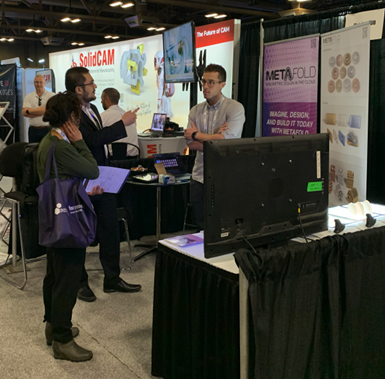
Metafold at Formnext Forum Austin.
Photo Credit: Additive Manufacturing Media
So one of my big takeaways from Formnext Forum Austin was lattices, particularly the prevalence and use of lattices and even research here. So first off going back to Carolyn Seepersad research. She talked also about investigating lattices, particularly the difficulty with strut imperfections to better analyze the lattice structures and identify potential corrective uses, using modeling design and prototyping. Next up for lattice design, I saw what we've talked about a lot throughout this podcast, the Wilson airless basketball at the EOS tour, and how the lattice enabled this geometric phenomenon of a design. If you bounce this, you know exactly what I mean. And lastly, I stopped by Metafold 3D's booth on the expo floor to see a huge variety of lattice design sizes and materials their customers were able to make using their problem solving smart software, from sunglass frames to shoes for commercial industries to parts for medical and aerospace, the need for smart easily generated designs for complex geometries like lattices in the AM field is an interesting thing to keep an eye on.
Peter Zelinski 41:43
Okay, one last takeaway. I want to come back to Trevor Johnstone of Design Fusion. Because a big part of our event Formnext Forum, were, there were the people there who were succeeding with additive manufacturing. But then there were all the newcomers there, too, all the new faces, and it's people who will be succeeding with additive manufacturing. They're there because they recognize additive's their future, but they're not there yet. Trevor Johnstone spoke to that group of people. And he was giving advice in how to think about moving forward with additive. And one piece of advice he gave, pick the biggest project you can handle and work back to smaller projects from there. And he pointed out almost every company starting forward with additive does the opposite of this, they start with something really small and, and very manageable first. He says start with the very biggest project you can get away with, take that on, because A) it's going to attract talent, your engagement with additive at that level is going to bring people into your organization, potentially, who are going to help you on this additive journey. And also, because it's going to solidify the company's internal commitment to additive, the inherently big project is going to require conversations with different stakeholders and is going to require a level of investment that is going to get management involved. The big project gets management's buy in, so if the journey includes some setbacks, some stumbles there is this buy in and stability all built in that is not only going to carry the big project forward, but create this umbrella of succeeding with smaller projects along the way. I thought that was really great advice.
Stephanie Hendrixson 43:39
Go big, or go home.
Peter Zelinski 43:43
Alright, so this has been a big episode. Why don't we go home. Thank you for listening to AM Radio, we're gonna put links related to everything we've talked about in the show description. If you like the show, tell people about it. We're growing audience of this podcast and we want even more. Tell your friends, subscribe to AM Radio on your favorite podcast platform and if you can give us a five-star rating that really helps.
Stephanie Hendrixson 44:09
And so as we mentioned near the beginning, it's going to be a while before the next Formnext event comes to the US, so if you'd like more additive applications, trends, success stories, more stuff like what we've talked about in this podcast, you can find all of our reporting over at additivemanufacturing.media. Thanks for listening.
Peter Zelinski 44:28
AM Radio is recorded with help from Austin Grogan. The show is edited by Jodee McElfresh and Stephanie Hendrixson. Our artwork is by Kate Schrand. AM Radio and Additive Manufacturing Media are products of Gardner Business Media located in Cincinnati, Ohio. I'm Pete Zelinski. Thanks for listening.
Related Content
With Electrochemical Additive Manufacturing (ECAM), Cooling Technology Is Advancing by Degrees
San Diego-based Fabric8Labs is applying electroplating chemistries and DLP-style machines to 3D print cold plates for the semiconductor industry in pure copper. These complex geometries combined with the rise of liquid cooling systems promise significant improvements for thermal management.
Read MoreVideo: 5" Diameter Navy Artillery Rounds Made Through Robot Directed Energy Deposition (DED) Instead of Forging
Big Metal Additive conceives additive manufacturing production factory making hundreds of Navy projectile housings per day.
Read MoreAdditive Manufacturing Is Subtractive, Too: How CNC Machining Integrates With AM (Includes Video)
For Keselowski Advanced Manufacturing, succeeding with laser powder bed fusion as a production process means developing a machine shop that is responsive to, and moves at the pacing of, metal 3D printing.
Read MoreHow Machining Makes AM Successful for Innovative 3D Manufacturing
Connections between metal 3D printing and CNC machining serve the Indiana manufacturer in many ways. One connection is customer conversations that resemble a machining job shop. Here is a look at a small company that has advanced quickly to become a thriving additive manufacturing part producer.
Read MoreRead Next
Alquist 3D Looks Toward a Carbon-Sequestering Future with 3D Printed Infrastructure
The Colorado startup aims to reduce the carbon footprint of new buildings, homes and city infrastructure with robotic 3D printing and a specialized geopolymer material.
Read MoreCrushable Lattices: The Lightweight Structures That Will Protect an Interplanetary Payload
NASA uses laser powder bed fusion plus chemical etching to create the lattice forms engineered to keep Mars rocks safe during a crash landing on Earth.
Read MorePostprocessing Steps and Costs for Metal 3D Printing
When your metal part is done 3D printing, you just pull it out of the machine and start using it, right? Not exactly.
Read More

.jpg;width=70;height=70;mode=crop)



